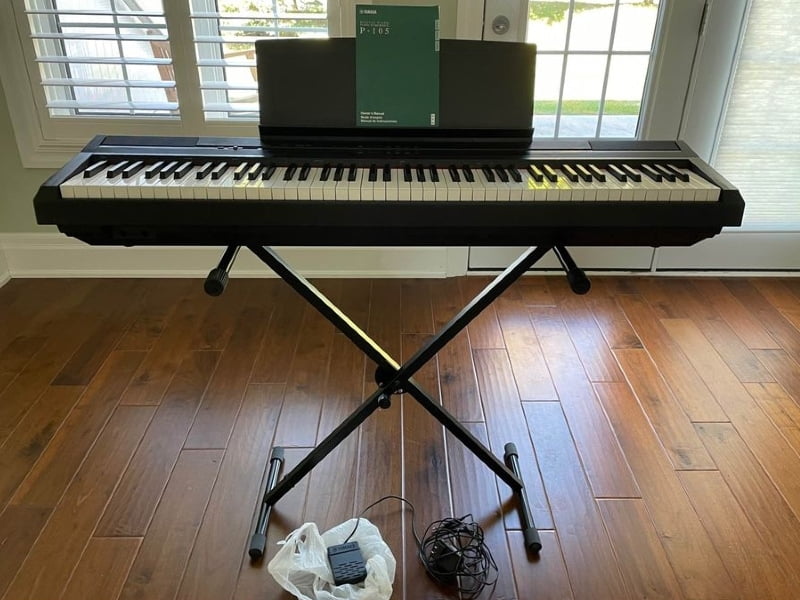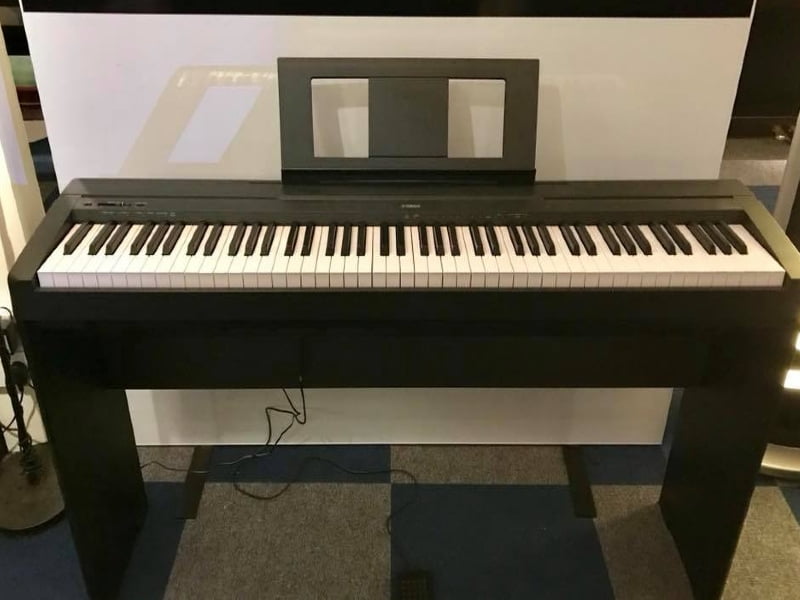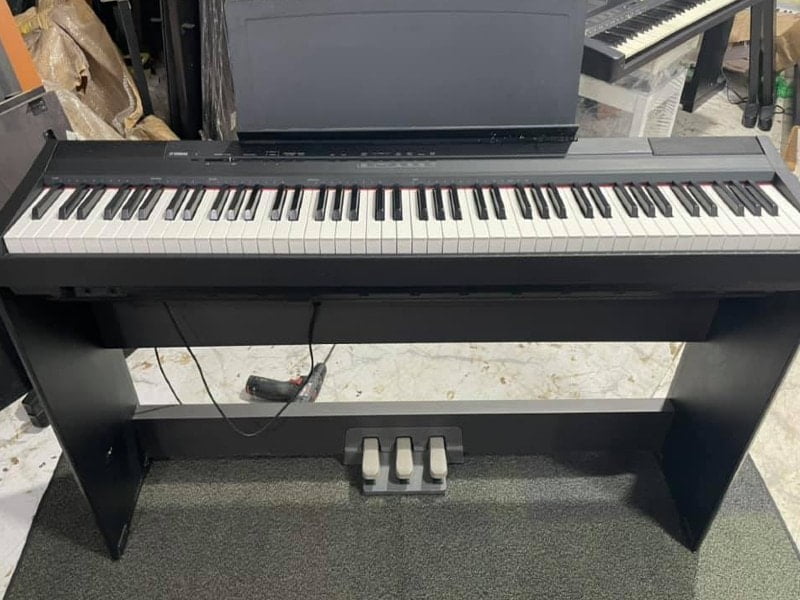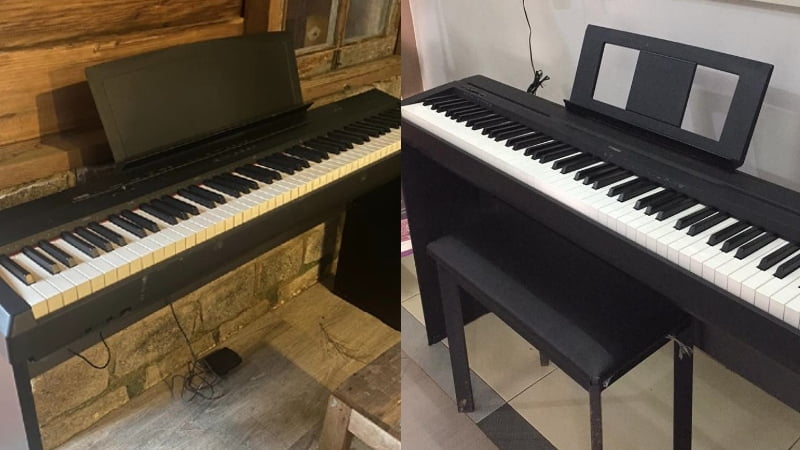Discover which Yamaha portable piano is the best in this Yamaha P45 vs P105 comparison.
Yamaha is one of the most trusted piano brands in the world. And two of the brand’s digital pianos that caught my eye were the P45 and the P105. These are some of the most popular models in Yamaha’s range of portable digital pianos, so comparing the two is a no-brainer.
That said, figuring out the better option is a different problem.
When testing these two pianos and comparing them head to head, I found that the P-105 is the better option. Even if it’s the more expensive option and hard to find nowadays, it comes with a great set of piano features, amazingly rich tones, and a lot of versatility.
On the flip side, the Yamaha P45 is more affordable and widely available. So, there are some pianists that might find this to be the better option.
In this Yamaha P45 vs P105 comparison, I’ll be explaining the features of both pianos and why the P-105 offers more versatility. And by the end, you’ll easily be able to choose the best piano for your needs!
Yamaha P45 vs P105: Comparison Chart


Last update on 2025-06-26 / Affiliate links / Images from Amazon Product Advertising API
Yamaha P45 vs P105: The Features
It can be hard to compare two digital pianos. But to get the most objective winner, I compared each of the piano’s features against each other. And when I did this with the P45 and P-105, the 105 came out on top with a score of 3-1.
The Yamaha P105 has a better tone generator, a wider sound library, and a great set of piano features. This is a definite upgrade over the P45, but I was still surprised to see that the P45 easily competes with the P105. And in this section, I’ll explain this comparison in much more detail.
Tone
The winner: Yamaha P105
The first feature I compared was the tone. After all, when you’re buying a digital piano, your first priority should be finding one that sounds good. And since both pianos come from Yamaha, you can expect them to have rich and bright piano tones.
However, I gave the point to the Yamaha P105 because it had a wide set of voices and a more advanced tone generation system. The Yamaha P45 put up a good fight, but the P105 was the clear winner.

+Sound Library
Before anything else, let’s look at the sound library. Since these are digital pianos and not arranger pianos, you shouldn’t expect too many voices. That said, the Yamaha P45 comes with ten top-quality voices that include acoustic and electric piano, strings, bass, and organ sounds. So, you’ll have more than enough voices to experiment and try out different sounds.
On the flip side, the Yamaha P105 comes with 14 voices. Now, this isn’t much more than the P45, but you definitely have more options on the P105. So, if you’re looking for more choices regarding sounds on your piano, the P105 offers more versatility.
+Tone Generation
The next comparison point I had was the tone generator of the pianos. The P45 comes with AWM Stereo Sampling, which is typical of an entry-level Yamaha digital piano. This is a great tone engine as it has rich piano voices that are very realistic. While they still have a digital characteristic to them, the piano voices on the Yamaha P45 are far better than most in its price range.
And while the P45’s sound quality surprised me, it still couldn’t compete with the P105. This is because the P105 uses the Pure CF Sound Engine, which is the more modern option from Yamaha. This tone engine utilizes samples recorded from real Yamaha CF Grand Pianos, which are considered some of the best grand pianos available.
And since the P105 beat out the P45 when I compared the tone engine and the sound library, it easily won out in this comparison.
Feel & Playability
The winner: Tie
I always try to ensure when buying a digital piano that it feels realistic and close to an acoustic piano. And for their price, both of these pianos do a great job of replicating the weight of a real piano. That said, they both fell short in terms of key texture, which can be a major issue for some pianists.
These pianos share the same hammer action system and the same keys. So, I had no choice but to give both of them a point in this comparison.
+Hammer Action
Both pianos use the Graded Hammer Standard or GHS system, that’s a signature feature of Yamaha digital pianos. While this is their entry-level hammer action system, it’s far more premium than others in the same price range. This is because the GHS system replicates the actual weight you feel when playing an acoustic piano.
So, you can expect both pianos to have heavier keys on the lower side and lighter keys on the higher side. This isn’t a feature that’s common among entry-level digital pianos, which is why the Yamaha collection of portable pianos is one of my favorites on the market
+Key Texture
The second comparison point I had when it came to the feel was the key texture. Sadly, both pianos have glossy plastic keys. This means there’s a slightly slippery feel when playing them that’s very obvious if you’re used to playing acoustic pianos.
Now, this isn’t that big of a deal. If you want a piano with a realistic key texture and graded hammer action, you usually have to pay extra. That said, it would have been great if any of these pianos featured textured or wooden keys.

Piano Features
The winner: Yamaha P105
To end my comparison, I compared the extra piano features on both instruments. And since the Yamaha P105 is more expensive, it should come as no surprise that is has a better feature set. This is another reason why I found the Yamaha P105 to offer more value for the money than the P45. So let’s dive deeper into the features that both pianos have to offer.
+Playing Modes
To start, let’s look at the playing modes. The Yamaha P105 comes with all the playing modes you’d expect from a good digital piano. This includes split, dual, and lesson (duo) modes. All of these features are very useful and make the piano a very flexible instrument for students and performing musicians alike.
With split mode, you divide the piano into two distinct zones, each with its own voice. That way, it seems like you’re playing two instruments at the same time. This is great for jamming, playing with a band, or for accompaniment.
Dual mode allows you to combine two voices together and blend them. This is a great way to experiment with different sounds to find something that fits your musical style.
Lastly, lesson mode divides the piano into two smaller keyboards with the same voice. This is great for piano lessons and also allows you to play piano duets with another person using the instrument.
The Yamaha P45 only comes with dual and lesson modes. So, while it still offers some versatility, it’s not as much as the P105.
+Effects
Both of these pianos come with a great reverb effect. However, the Yamaha P105 also comes with IAC and damper resonance. These effects give you more control over the tone, though I will admit these aren’t effects you will need too much, especially since the piano tones on the P105 are rich, to begin with.
+Polyphony
Lastly, I compared the polyphony of the two pianos. The Yamaha P45 comes with 64-note polyphony, which isn’t bad and is more than enough for beginners and novices. However, the Yamaha P105 comes with 128-note polyphony, which is another reason for the higher-quality tones.

Yamaha P45 vs P105: The Similarities
Both of these pianos come from the same collection. They are both portable and versatile pianos that come at a fair price. Both of these pianos will be great options if you’re a beginner or novice pianist. They have decent sound libraries and rich piano tones and have all the features you’d need when starting your musical journey.
These pianos are around the same weight. So, they are both relatively easy to bring around with you. This is great if you’re heading to a jam, practice, or piano lessons. But if you’re looking for an instrument to last you a long time and offer more versatility, the P105 might offer more value for the money.
Quick Rundown of the Yamaha P45
- Includes the P45 Digital Piano, power adapter, sustain pedal and music rest
- 88 fully weighted piano style keys simulate the feel of an acoustic piano and provide a quality playing experience
- GHS weighted action is heavier in the low end and lighter in the high end, just like an acoustic piano
- Contains 10 different voices, including digitally sampled tones from real Yamaha acoustic grand pianos
- Dual mode lets you combine 2 voices together, like piano and strings, for an inspiring new playing experience. Tuning- 414.8 - 440.0 - 446.8 Hz
Last update on 2025-06-26 / Affiliate links / Images from Amazon Product Advertising API
Quick Rundown of the Yamaha P105
- PureCF-Sampled Piano: PureCF-Sampled Piano Sampled from Yamaha's own acclaimed CFIII concert grand, no digital piano at this price point delivers recordings from such a high-end instrument.
- Pianist styles: Pianist styles This built-in duet partner plays along with you in one of ten different playing styles.
- Built-in drum patterns: Built-in Drum Patterns Basic drum patterns put the "fun" back into practicing and is a practical alternative to a metronome. Or turn your solo act into a two piece band where the dummer is always on time.
- 128-Note Polyphony: 128-Note Polyphony Even when using dual Voice and split mode with a drum pattern, 128-note polyphony ensures every note gets heard.
- Intelligent Acoustic Control: Optimized for the built-in, 2-way, stereo speaker system, the P105 EQ automatically adjusts to your volume setting to ensure the absolute best tone at any playing level.
Last update on 2025-06-26 / Affiliate links / Images from Amazon Product Advertising API
Product Videos
Related Articles to Yamaha P45
- Yamaha P45 vs P45B: What’s the Real Difference?
- Yamaha P45 vs DGX-650: Is the DGX-650 Worth the Higher Price?
- Yamaha P-35B vs P45: Finding the Best Affordable Yamaha Piano
- Yamaha P45 Vs DGX-660: A Head-to-Head Comparison
- Yamaha P45 vs Williams Rhapsody II: A Head-to-Head Comparison
- Yamaha P45 Vs NP32: A Head-to-Head Comparison
- Yamaha P45 vs Williams Allegro III: Finding the Best Digital Piano on a Budget
- Yamaha P45 vs YPG 535: Which Is the Best Affordable Yamaha Piano?
- Yamaha P60 vs P45: Finding the Best Yamaha Portable Digital Piano
- Alesis Recital Vs Yamaha P45: Which Offers Great Value For Money?
- Donner DEP-10 Vs Yamaha P-45: Which Digital Piano Is Better?
- Yamaha P45 Vs Korg B2: Which Digital Piano Fits Beginners Better?
- Yamaha P45 VS P115: Which P-Series Newbie Gives You More Value for Money?
- Yamaha P45 vs Casio CDP S100: Finding the Better Bet for Beginners
- Yamaha P45 vs YDP 103: Should You Get a Portable or Console Digital Piano?
- Alesis Recital Pro vs Yamaha P45: Which Should You Get As Your First Piano?
- Yamaha P45 vs Roland FP10: Which Entry Level Titan Takes the Top Spot?
- Yamaha P45 vs Donner DEP 20: Which Model Is the Better Option for Beginners?
- Yamaha P45 vs Casio PX 770: Should You Get the Portable or Console Digital Piano?
- Alesis Prestige Artist vs Yamaha P45: Can Alesis Hold Its Own Against the Popular Yamaha Model?
- Yamaha P45 vs P125: Why the Yamaha P125 Is the Better Pick for Pianists
- Yamaha P71 vs P45: Why the Amazon Exclusive P71 is the Better Digital Piano
References:
- Yamaha P45: https://usa.yamaha.com/products/musical_instruments/pianos/p_series/p-45/specs.html#product-tabs
- Yamaha P105: https://europe.yamaha.com/en/products/musical_instruments/pianos/p_series/p-105/specs.html
Lulacruza is an electronic folk duo operating at the junction of the hypermodern and the ancient. Our music weaves together hypnotic female singing, South American folk instruments and electronic processing, while channeling pulsating waves from the source of creation.
Lalucruza is also a community where you can connect with other music lovers to collaborate, exchange ideas and share knowledge. A platform for who wants to learns the basics of playing piano, guitar, drum masters’ technique, etc.. is the premise of our website.
